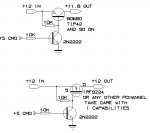Okay as some of you know I am new to a lot of this, but learning quickly and having fun. I have a completed my first master piece, and now its time to improve it, and in the process learn more about transistors.
Currently I turn on a 12v 20w MR16 using a Reed Relay but instead I want to use a transistor. Is that possible? So far all of the NPN i've looked (and tried) appear far to weak to handle 20w. So once again I turn to you for help. The research so far of the internet has turned up way too many conflicting stories.
BTW - A little more on my project:
Unit 1 - RF remote sensor
Use a PIR and RF transmitter. On detection it sends a signal to the base station.
Unit 2 - IR remote sensor
Use a PIR and IR transmitter. On detection it sends a signal to the base station.
Unit 3 - Base Station
can receive either RF or IR from remote sensors to active a hacked HD video camera that will film base on the dip switch setting. It also has a LDR to determine if the flood light needs to be turned on.
Currently I turn on a 12v 20w MR16 using a Reed Relay but instead I want to use a transistor. Is that possible? So far all of the NPN i've looked (and tried) appear far to weak to handle 20w. So once again I turn to you for help. The research so far of the internet has turned up way too many conflicting stories.
BTW - A little more on my project:
Unit 1 - RF remote sensor
Use a PIR and RF transmitter. On detection it sends a signal to the base station.
Unit 2 - IR remote sensor
Use a PIR and IR transmitter. On detection it sends a signal to the base station.
Unit 3 - Base Station
can receive either RF or IR from remote sensors to active a hacked HD video camera that will film base on the dip switch setting. It also has a LDR to determine if the flood light needs to be turned on.


